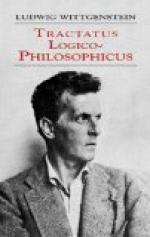4.126 We can now talk about formal concepts, in the same sense that we speak of formal properties. (I introduce this expression in order to exhibit the source of the confusion between formal concepts and concepts proper, which pervades the whole of traditional logic.) When something falls under a formal concept as one of its objects, this cannot be expressed by means of a proposition. Instead it is shown in the very sign for this object. (A name shows that it signifies an object, a sign for a number that it signifies a number, etc.) Formal concepts cannot, in fact, be represented by means of a function, as concepts proper can. For their characteristics, formal properties, are not expressed by means of functions. The expression for a formal property is a feature of certain symbols. So the sign for the characteristics of a formal concept is a distinctive feature of all symbols whose meanings fall under the concept. So the expression for a formal concept is a propositional variable in which this distinctive f
eature alone is constant.
4.127 The propositional variable signifies the formal concept, and its values signify the objects that fall under the concept.
4.1271 Every variable is the sign for a formal concept. For every variable represents a constant form that all its values possess, and this can be regarded as a formal property of those values.
4.1272 Thus the variable name ‘x’ is the proper sign for the pseudo-concept object. Wherever the word ‘object’ (’thing’, etc.) is correctly used, it is expressed in conceptual notation by a variable name. For example, in the proposition, ‘There are 2 objects which. . .’, it is expressed by ’ (dx,y) ... ’. Wherever it is used in a different way, that is as a proper concept-word, nonsensical pseudo-propositions are the result. So one cannot say, for example, ‘There are objects’, as one might say, ‘There are books’. And it is just as impossible to say, ‘There are 100 objects’, or, ’There are !0 objects’. And it is nonsensical to speak of the total number of objects. The same applies to the words ‘complex’, ‘fact’, ‘function’, ‘number’, etc. They all signify formal concepts, and are represented in conceptual notation by variables, not by functions or classes (as Frege and Russell believed). ‘1 is a number’, ‘There is only one zero’, and all similar expressions are nonsensical. (It is just as nonsensical to say, ’There is only one 1’, as it would be to say, ’2 + 2 at 3 o’clock equals 4’.)
4.12721 A formal concept is given immediately any object falling under it is given. It is not possible, therefore, to introduce as primitive ideas objects belonging to a formal concept and the formal concept itself. So it is impossible, for example, to introduce as primitive ideas both the concept of a function and specific functions, as Russell does; or the concept of a number and particular numbers.




